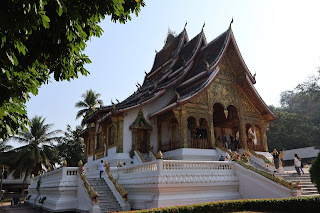The Royal Palace (official name Haw Kham) in Luang Prabang, Laos, was built in
1904 during the French colonial era for King Sisavang Vong and his family.
The site for the palace was chosen so that official visitors to Luang Prabang
could disembark from their river voyages directly below the palace and be
received there.
After the death of King Sisavang Vong, the Crown Prince Savang Vatthana and
his family were the last to occupy the grounds.
In 1975, the monarchy was overthrown by the communists and the royal family
were taken to re-education camps. The palace was then converted into a
national museum.
|
Entrance to the National Museum of Luang Prabang.
On the left side is the Royal Palace and on the right side is the Haw
Phra Bang (Delicate Buddha Chapel).
|
|
The Royal Palace in Luang Prabang.
The architecture of the palace has a mix of traditional Lao motifs and
French Beaux-Arts styles.
-
It is laid out in a double-cruciform shape, with the entrance on one
side of the lower crossbar.
-
Above the entrance is a three-headed elephant sheltered by the sacred
white parasol, the symbol of the Lao monarchy.
- The steps to the entrance are made of Italian marble.
|
|
Haw Phra Bang (Delicate Buddha Chapel) seen from the south.
The Haw Phra Bang is located at the northeastern corner of the grounds
of the Royal Palace Museum.
-
Although it is a new structure, it is built in the traditional style.
-
The Haw Phra Bang has been designed as the permanent home/shrine for
the Phra Bang (Delicate Buddha), Luang Prabang's namesake and most
sacred image.
-
The image, brought to Luang Prabang in 1359, earlier had places of
honor in various city wats (including Wisunalat and Mai).
-
Most recently it has been on display in the Royal Palace Museum from
which location it is carried to Wat Mai for ritual cleansing during
the city's New Year's celebration.
|
|
Haw Phra Bang (Delicate Buddha Chapel) seen from the southwest.
The Haw Pha Bang is built in the traditional Luang Prabang style, but
using modern construction techniques and materials, and is set on an
exaggerated platform, befitting its special role as repository of the
paladin of the city.
-
It is highly ornate with gold and glass decoration covering much of
its exterior and interior surfaces.
-
A number of naga-flanked stairways and an elaborate multi-faceted roof
structure add to its over-all impact.
|
|
Haw Phra Bang (Delicate Buddha Chapel) seen from the west.
|
|
Detail of the south door of the facade.
|
|
Haw Phra Bang (Delicate Buddha Chapel) seen from the west.
|
|
Northeast side (rear) of the chapel.
|
|
Phra Bang (Delicate Buddha).
The sacred Phra Bang (Delicate Buddha) is 83 cm, almost 33 inches, tall
and is 90% gold with additional silver and bronze alloys. It weighs
around 50 kg, or 110 lb.
-
The statue, with both hands raised in the attitude of Abhayamudra
(dispelling fear and offering protection to those who would give it
honor) served as a unifying force for religious and royal traditions.
-
Although it appears to be of 14th century Khmer origin, legend dates
it from Sri Lanka in the first century AD.
-
In 1359 the Khmer king gave the Pra Bang to his son-in-law, the first
Lang Xang monarch Fa Ngum (1353-1373); it was to provide Buddhist
legitimacy both to Fa Ngum's rule and theoretically to the sovereignty
of Laos.
-
In 1563 King Sai Setthathirat (1548-1571) brought the Pra Bang with
him to his new capital at Vientiane.
-
On several occasions (c. 1778 and c. 1827) Siamese invaders took it
back to their lands, but Rama IV, King Mongkut, finally returned it in
1867.
-
It was placed first in Wat Wisunalat; then the French moved it to Wat
Mai for safekeeping in 1984.
-
After a rather complicated series of changes it was placed in the
Royal Palace Museum in 1947.
- Photography in the public domain.
-
See more at
Phra Bang - Wikipedia.
|
See also
Source
Location




















